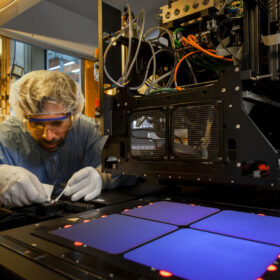UK targets 45 GW solar, 22 GW BESS in Clean Power 2030 plan
Policies and targets confirmed in 138-page government plan to decarbonize Great Britain’s electricity generation by 2030. Solar and storage to play a key role alongside market reforms, changes to planning process, and a revamped connections queue.
Patents to add AI to power grids are surging, says IEA
New patents to integrate artificial intelligence into global grids have grown sixfold over the past few years, with China driving overall innovation momentum. The European Patent Office, co-authors of the report, called for Europe to renew its efforts.
Standards and transparency key to solar sustainability
Discussions at the Sustainable Solar Europe event, held yesterday in Brussels, reveal that clearly recorded and available information is the key to ensuring sustainable and ethical practices all along the solar supply chain. And clear standards for the accuracy and relevance of this information are needed to ensure that all are moving toward the same target. The day also saw the launch of such a standard in the Solar Stewardship Initiative’s Supply Chain Traceability Standard.
‘Equity requires addressing structural barriers in hiring and promotions’
This week, Women in Solar Europe gives voice to Eyerusalem Mekuria Wondemu, Project Engineer at Switzerland’s Gruner Stucky SA. She says changes in career paths are slow due to entrenched cultural norms and unconscious prejudices, but growing advocacy and representation drive progress. “Mentorship, continuous learning, and networking are critical,” she states.
UK government seeking developers for solar project in Cyprus
The UK Ministry of Defence has launched a tender for a 875 kW solar array to be built within its base in Cyprus. The deadline for expressions of interest is Jan. 14, 2025.
Gibraltar opens tender for rooftop solar arrays
The Gibraltar government is seeking developers to install rooftop solar systems at selected sites across the British Overseas Territory. It will also consider proposals for solar canopies and floating solar as part of the tender. The deadline for expressions of interest is Jan. 24, 2025.
Spanish researchers find revamping modules and inverters is the most profitable strategy
A group of researchers have carried out a techno-economic analysis of three revamping strategies for an operating photovoltaic power plant in southeast Spain. They found the highest production value by installed power is obtained when both the modules and inverters are replaced.
Belgian startup raises $2.5 million for grid orchestration software
Powernaut’s software balances local generation from decentralized devices such as solar panels, batteries, and heat pumps with the needs of the power grid.
Fraunhofer ISE developing copper metallization for tandem perovskite-silicon solar cells
The German research institute said it is currently exploring three copper metallization methods: Screen printing, FlexTrail printing and rotary printing. The proposed technology is reportedly compatible with either TOPCon or heterojunction bottom cells.
Improving vertical bifacial PV system performance with free-space luminescent solar concentrators
New research from the Netherlands shows that using free-space luminescent solar concentrators could be used to considerably increase bifacial solar module performance in vertical residential setups. The scientists are confident that a variety of bifacial PV systems incorporating this technology can be designed and deployed in the future.










